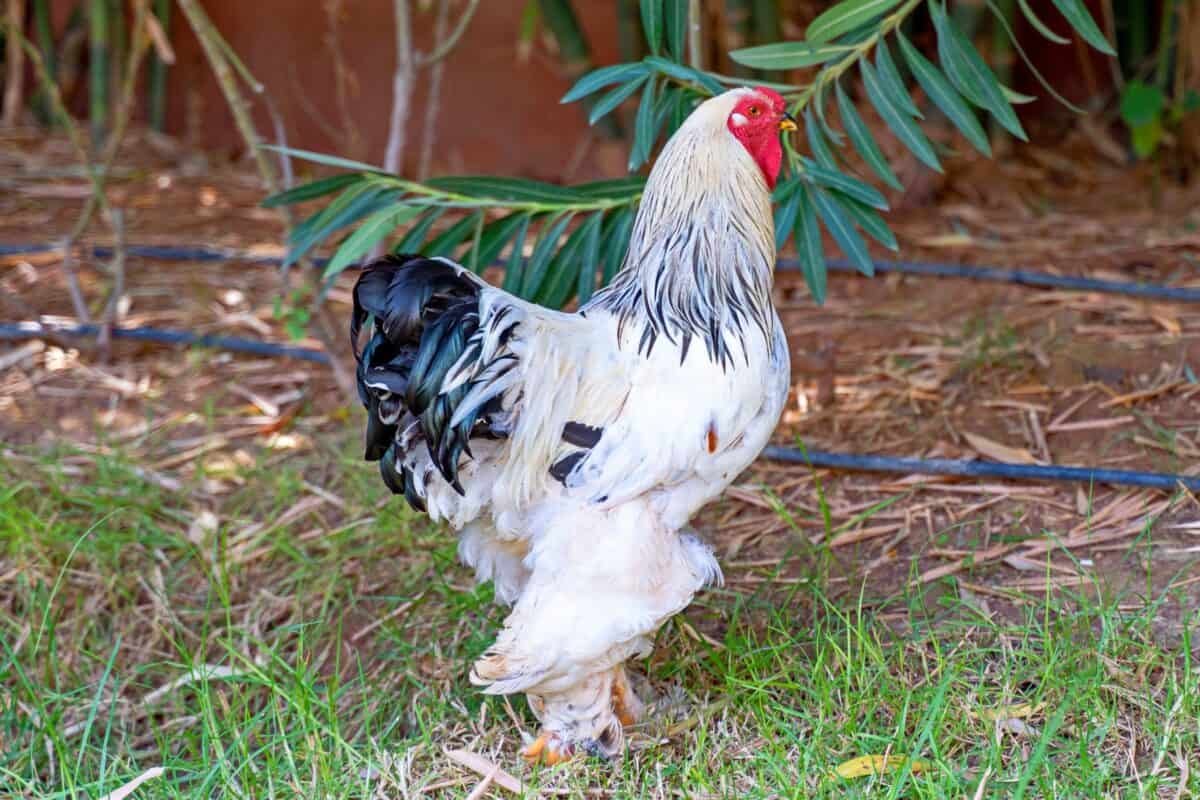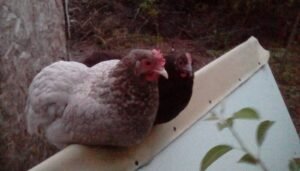Growing up, I always considered our chickens a bit of a motley crew, but nothing prepared me for the awe-inspiring presence of the Brahma chicken. The first time I saw one, I was struck by its sheer size, feathered feet, and calm demeanor. It was less like a chicken and more like a feathered, feathery-legged dinosaur. Since then, I’ve had the pleasure of raising them myself and learning exactly why they’re nicknamed the “King of Chickens.”
In this comprehensive guide, we’ll dive deep into everything you need to know about this remarkable breed. You’ll learn about their unique history, distinctive physical traits, and how to properly care for them through every season. We’ll also cover their egg-laying habits, detailed growth stages, and even the cost of adding these magnificent birds to your flock. By the end, you’ll understand why the Brahma chicken isn’t just a bird; it’s a heritage breed with a captivating personality that’s perfect for any backyard enthusiast looking for a docile and productive hen.
As an experienced poultry keeper with over a decade of experience, I’ve worked with many breeds, but the Brahmas hold a special place. I’ve personally seen how their gentle nature and surprising hardiness make them an excellent choice for family farms and homesteads.
Brahma Chicken Quick Facts
| Statistic | Details |
|---|---|
| Type | Heritage, Dual-Purpose |
| Egg Color | Medium to large brown eggs with a creamy tint |
| Egg Production | 3-4 eggs per week (150-200 per year) |
| Temperament | Gentle, calm, friendly, and docile |
| Adult Weight | Rooster: 10-14 lbs (4.5−6.4 kg), Hen: 8-10 lbs (3.6−4.5 kg) |
| Lifespan | 5-8 years, though some live up to 10 years |
| Standard Varieties | Light, Dark, Buff |
| Distinguishing Feature | Heavily feathered feet and legs, pea comb |
History and Origin of Brahma Chickens
The story of the Brahma chicken is a fascinating journey that crosses continents and centuries. To truly appreciate this “giant chicken breed,” you have to understand its deep historical roots, a story that begins in the East and ends in the farmyards of America.
The origins of the Brahma are still debated, but the most widely accepted theory traces them back to large fowl, known as “Shanghai chickens,” imported to America in the 1840s from the Chinese port of Shanghai. These original birds were likely a cross between the large Cochin fowl and a breed known as the Gray Chittagong from India. These initial birds, which gave rise to the breed, were often called “Gray Chittagongs” or “Chittagong-Brahmas” due to their origin. The term “Brahma fowl” came from the Brahmaputra River in India, reflecting their geographical heritage.
These giant birds were first brought to America by sea captains, sparking what became known as the “hen fever” of the 1850s—a period of intense obsession with breeding and showing exotic poultry in both America and Britain. This craze was fueled by the magnificent size and unique appearance of breeds like the Brahma. One of the most notable figures in this development was George Burnham, an influential poultry breeder from Massachusetts.
He played a key role in standardizing the breed and promoting it as a premier American fowl. At the peak of their popularity, some roosters were recorded to have reached an extraordinary weight of up to 18.25 lbs, and historical records often cited weights between 17 and 18 lbs (7.7−8.2 kg) during the late 19th and early 20th centuries. Burnham’s efforts helped to refine the breed’s characteristics, solidifying its place in American agriculture and hobbyist circles.
The Brahma’s popularity skyrocketed, so much so that Queen Victoria of England was gifted a flock of nine Brahma chickens in 1852. This gift further cemented the breed’s reputation on an international scale. The breed was officially recognized by the American Poultry Association (APA) in its first Standard of Perfection in 1874 (APA, 1874), solidifying the Light and Dark Brahma varieties. The Buff Brahma was added later by the APA (APA, n.d.), creating the three standard color varieties we know today.
The Brahma fowl quickly became a popular dual-purpose chicken, valued for both its substantial meat and its ability to lay eggs even in the coldest months. According to The Livestock Conservancy, the Brahma is a recognized heritage breed due to its historical significance and conservation efforts. While they are no longer as commercially popular as they once were, their place in poultry history as a heritage chicken is secure, and they continue to be celebrated by backyard chicken keepers around the world.
The American Bantam Association also recognizes the Brahma bantam, a miniature version of the breed, which has its own following. Brahmas are one of the most popular breeds to be miniaturized, and the Brahma bantam is officially recognized by the APA as well, making them a popular choice for urban keepers or those with limited space.
- Bantam Brahma Weights: For those interested in the miniature version, Brahma bantam roosters typically weigh 38 ounces (1077 g) and hens weigh 34 ounces (964 g).
The Brahma’s journey from a rare import to a backyard favorite is a testament to its enduring appeal. This fascinating history is only the beginning of what makes these birds so special. Let’s now explore the physical traits that make them so recognizable.
Physical Characteristics and Appearance
There’s no mistaking a Brahma for another breed. When people ask me what a Brahma chicken size is like, I tell them they are truly giant. They are a large, stately breed with a broad body, full chest, and a proud, upright posture that gives them the look of the “King of chickens.”
Weight and Size
- Roosters typically weigh between 10 and 14 lbs (4.5 to 6.4 kg), with some exceptional birds reaching up to 18 lbs (8.2 kg). Oklahoma State University’s poultry guide confirms these weights. In some cases, a particularly large rooster can reach up to 14 pounds.
- Hens are slightly smaller, weighing in at 8 to 10 lbs (3.6 to 4.5 kg).
Their impressive size is matched by a well-proportioned, powerful frame. They are one of the tallest chicken breeds, with some roosters reaching over 30 inches tall. Their head is relatively small for their body, featuring a distinctive pea comb, which is a small, low comb with three rows of rounded bumps.
This unique comb is an adaptation that makes them highly resistant to frostbite, a huge benefit for poultry keepers in colder climates. Their prominent “beetle brow” — a slight projection of the skull over the eyes — gives them a distinctive look and adds to their weather resistance, as it helps shield their eyes from rain and snow. The small comb and dense feathering around their face and wattles provide excellent protection from the cold.
Color Varieties
The American Poultry Association recognizes three main color varieties, each with a unique and beautiful feather pattern. The American Brahma Club reports on the detailed standards for each of these varieties. While some sources mention Black and White as APA-recognized colors, the most widely accepted standard recognizes only Light, Dark, and Buff. It is always best to check the current APA Standard of Perfection for the most up-to-date information.
- Light Brahma: This is arguably the most common and classic variety. They have a brilliant white body with a striking black-and-white feathered pattern on their necks (known as the hackle) and tails. This beautiful contrast is a hallmark of the breed’s classic look, often described as a “Columbian” pattern. The hackle feathers are sharply defined with black, adding to their elegant appearance. The wings also have a black-tipped pattern that is visible when they are fully extended.
- Dark Brahma: My favorite of all, the Dark Brahma, has a stunning color pattern. Hens have a beautiful, intricate gray and black double-laced pattern, a complex design that adds to their regal appearance. The roosters, on the other hand, have a mostly black body with a striking white hackle and back, often with a metallic green sheen to the black feathers. The males often have a beautiful sheen to their black feathers.
- Buff Brahma: This variety has the same feather patterns as the Light Brahma, but the white is replaced with a rich, golden buff color. Their hackle and tail are a glossy black, creating a warm and elegant look. The buff color makes them look like living statues of gold and is highly sought after for its beauty. This variety is less common than the Light and Dark. A valuable trait for breeders is that Buff Brahmas are considered autosexing, with males typically having a lighter coloring than females at hatching.
While the APA recognizes only Light, Dark, and Buff varieties, breeders have developed other color variations including Blue Partridge and Silver Penciled. These non-standard varieties are not recognized by the APA but are popular among breeders and enthusiasts for their unique and beautiful feather patterns. The Blue Partridge, for example, features a stunning slate blue base with intricate red and black lacing.
When I first got my Light Brahmas, I was amazed by how the delicate patterns on their feathers seemed to get more intricate as they matured. They truly are one of the most aesthetically pleasing breeds of chickens. But they’re not just a pretty face; their production capabilities are just as impressive.
Brahma Chicken Egg Production
For a breed of its size, the Brahma chicken is a surprisingly good layer. They are a “dual-purpose” breed, which means they are raised for both meat and egg production.
Laying Habits and Egg Characteristics
A healthy Brahma hen will typically lay between 150-200 medium to large brown eggs per year, though production can vary based on individual birds and conditions. While this may not be as high as some commercial egg-laying breeds, they have a secret advantage: they are excellent winter layers. Their dense feathering and large bodies help them stay warm, so they continue to lay eggs even when other breeds have stopped for the season. Peak production occurs from October to May, making them exceptional winter layers. This is a huge benefit for poultry keepers in colder climates.
- When do Brahmas start laying? Brahmas are a slower-maturing breed and typically begin laying between 6-9 months of age, with most starting around 7 months. This is normal and is just a part of their slower, larger growth cycle.
- What color eggs do Brahma chickens lay? You can expect to find a nice medium to large brown egg in their nesting boxes. The eggs often have a creamy tint to them. The shells are quite sturdy, which helps with handling and storage.
- What time of day do chickens lay their eggs? Most chickens, including Brahmas, lay their eggs in the morning, typically between sunrise and midday.
Broodiness and Mothering Instincts
Brahma chicken hens are known for making exceptional mothers due to their calm and protective nature. Their large size allows them to cover a large clutch of eggs, and their gentle disposition makes them a joy to have in the brooder. If you’re looking to hatch chicks naturally, a Brahma hen is an excellent choice. However, if you’re not interested in hatching, you’ll need to “break” her of her broodiness by removing her from the nesting box a few times a day to encourage her to eat and drink. Due to their large size, be sure to monitor broody hens carefully as they may accidentally trample newly hatched chicks.
Egg-Laying Lifespan
While a Brahma hen can live for 5-8 years, her egg production will naturally decline after about her third or fourth year. Her peak laying years are typically the first two years of her life. After that, her production will slow down, but she can continue to lay eggs sporadically for many more years, though not at the same rate. This is a normal part of their lifecycle, and a hen’s worth extends beyond just her egg production.
Growth and Development
Brahmas are a slow-growing breed, which is something you must factor in if you’re raising them for meat or eggs. When people ask, “How long does Brahma take to grow?“, I tell them to be patient.
They can take anywhere from 10 to 18 months to reach their full adult size. This slower growth is part of what makes them a fantastic dual-purpose heritage chicken.
Detailed Feeding Guide
Providing the right nutrition is crucial for the healthy development of a Brahma. Their large size means they have different feeding needs than smaller breeds. For a comprehensive guide on what to feed your chickens, check out our guide on high-quality chick starter feed.
| Growth Stage | Age | Protein Content | Notes |
|---|---|---|---|
| Chicks | 0-8 weeks | 20-22% | Use a high-quality chick starter feed. Provide constant access to fresh, clean water. |
| Growers | 8-20 weeks | 18% | Transition to a grower feed. This supports their rapid feather and bone development. |
| Pullets/Roosters | 20+ weeks | 16% (Layer feed) | Hens need a layer feed with added calcium. Roosters can be on a maintenance feed. |
For a more detailed feeding schedule and guide on nutrition, check out our full guide. The slow growth cycle also contributes to the quality of their meat, which is known for being richer and more flavorful than that of faster-growing commercial broiler breeds.
- Meat Production Timeline: While Brahmas can be ready for the dinner table around 8-10 weeks, it takes a full year for them to reach their maximum size and meat potential.
Comparison with Other Breeds
When considering a Brahma chicken, it’s helpful to understand how they stack up against other popular breeds.
| Feature | Brahma | Jersey Giant | Leghorn | Orpington |
|---|---|---|---|---|
| Size | Giant (10-14 lbs rooster) | Giantest (13-15 lbs rooster) | Small (7.5 lbs rooster) | Large (10 lbs rooster) |
| Temperament | Very docile, friendly | Gentle, calm | Flighty, active | Docile, friendly |
| Egg Production | 150-200 eggs/year | 150-180 eggs/year | 250-300 eggs/year | 150-180 eggs/year |
| Laying Start | 6-7 months | 8-9 months | 4-5 months | 6-7 months |
| Distinguishing Feature | Feathered feet, pea comb | Large size, solid frame | White eggs, active | Fluffy appearance |
What is the biggest chicken breed?
While the Brahma is often called the “King of Chickens” for its imposing size, the Jersey Giant is actually the biggest chicken breed. A Jersey Giant rooster can weigh up to 15 pounds (6.8 kg), slightly larger than the Brahma. However, the Brahma’s dense feathering and impressive posture give it a majestic presence that is second to none.
Which chicken starts laying eggs the fastest?
If your priority is early egg production, the Brahma is not the fastest-laying chicken. Breeds like the Leghorn and the Rhode Island Red are known for maturing quickly and beginning to lay as early as 4-5 months of age. Brahmas, being a slower-maturing heritage breed, require more patience before they begin to produce eggs.
Care and Management
Proper care is essential for a happy and healthy Brahma flock. My favorite part of raising Brahmas is how easy they are to care for once you get the basics right.
Housing Requirements
Due to their size, Brahmas require more space than the average chicken. A general rule of thumb is to provide at least 5 square feet of coop space per bird, and a minimum of 10-15 square feet of run space.
- Roost Height: Due to their weight, Brahmas need lower roosting bars (no more than 2-3 feet off the ground) to prevent injury when they jump down. The roosting bars should also be wider than average to accommodate their large feet.
- Nesting Boxes: They need larger nesting boxes to comfortably lay their medium to large eggs. A box measuring at least 14×14 inches is a good standard.
- Ventilation: Good ventilation is crucial to prevent respiratory issues, especially in larger, enclosed coops.
Caring for Feathered Feet
The most unique care requirement for feathered feet chickens is regular maintenance. Their foot feathering can easily get caked with mud or droppings, which can lead to bacterial infections, mites, and even frostbite in cold, wet conditions.
- Keep the Run Dry: The best preventative measure is to ensure their coop and run are kept as clean and dry as possible. Use a well-draining bedding like sand in the run or pine shavings in the coop.
- Regular Cleaning: A simple, weekly foot check is all that’s needed. If you find mud caked on, simply soak their feet in a bowl of warm water with a little bit of mild soap or Epsom salts. Gently scrub the feathers with a soft brush and pat them dry with a towel.
- Trim Feathers: In some cases, you may need to trim the feathers around their feet with scissors to prevent a buildup of mud or droppings.
Climate & Soil
Brahmas thrive best on dry, well-drained soils, as their feathered feet can be prone to issues in damp, muddy conditions. Because of this, they are not an ideal breed for southern climates without special modifications to their coop and run to help them stay cool.
Climate-Specific Guidance
Brahmas are incredibly cold-hardy, but their dense feathers also make them susceptible to other climate-related issues. Here’s how to care for them in different regions.
Winter Care (Cold-Hardy)
- Frostbite Prevention: Their pea comb and small wattles are resistant, but their feathered feet can be vulnerable in wet, freezing conditions. Use a thick layer of dry bedding in the coop to prevent ice buildup on their feet.
- Water: Ensure their water doesn’t freeze. Consider a heated waterer to provide constant access to drinking water.
- Drafts: Seal any drafts in the coop while maintaining good ventilation.
Summer Care (Heat-Prone)
- Shade: Provide plenty of shade in their run. Their large size and dense feathering make them prone to heat stress. This is especially important in humid, southern climates.
- Cool Water: Keep fresh, cool water available at all times. Place ice cubes in their water to help them cool down.
- Ventilation: Ensure maximum airflow in the coop to prevent overheating. Avoid overcrowding.
- Frozen Treats: Chickens love frozen treats like frozen corn on the cob or chunks of watermelon.
Common Health Issues
Disclaimer: This article is for informational purposes only and is not a substitute for professional veterinary advice.
While Brahmas are a hardy breed, they are susceptible to a few specific health issues due to their physical traits.
- Bumblefoot: This is a bacterial infection of the foot pad, often caused by cuts or scrapes that get infected. Their feathered feet can trap dirt and moisture, increasing the risk.
- Scaly Leg Mites: The mites burrow under the scales of the legs, causing them to lift and become crusty. Their feathered feet make it harder to spot this issue early.
- Feather Lice and Mites: Their dense plumage can provide a perfect home for these parasites. Regular dust bathing and preventative measures are essential.
Prevention and Treatment
- Cleanliness: The single best preventative measure is keeping their coop and run clean and dry.
- Regular Checks: Do a weekly check of their feet and legs for any signs of injury or mites.
- Treatment: For mites, a leg soak followed by a topical treatment like petroleum jelly can suffocate the mites.
Temperament and Behavior
The “Gentle Giants” nickname isn’t just for show; it’s a perfect description of the Brahma’s temperament. They are an extremely docile and friendly breed, rarely displaying aggression toward humans or other chickens. In fact, brahma chicken roosters are particularly gentle and are not typically aggressive, making them a great choice for a mixed-gender flock. My hen, Beatrice, is so calm that she will happily eat out of my hand and doesn’t mind being picked up.
Interaction with Humans
They are great with children and make for an excellent family pet. Their calm nature makes them a joy to have in the backyard, as they are not flighty or high-strung. They are slow-moving and predictable, which is reassuring for new chicken keepers.
Flock Dynamics
Brahmas are low on the pecking order and don’t typically pick fights with other birds. They can be bullied by more aggressive breeds, so it’s important to house them with other calm breeds like the Orpington or Cochin. Their large size and imposing presence, however, can act as a natural deterrent to small predators.
Can Brahma Chickens Fly?
Due to their large size and weight, Brahmas are not great flyers. They can only get a few feet off the ground, which makes them easy to contain in a standard-height fence. You don’t have to worry about them flying over a 4-foot fence.
This calm and gentle disposition is a major selling point for backyard chicken keepers. This temperament, combined with their unique characteristics, makes them a wonderful addition to a flock.
Breeding Brahma Chickens
Breeding Brahmas can be a rewarding experience.
Hatching and Incubation
- Hatching Time: Brahma chicken eggs typically hatch in 21 days, just like other chicken breeds.
- Incubation: Due to their large size, the eggs may require a bit more attention in the incubator. Make sure to rotate them regularly and maintain proper humidity.
Genetics
The color patterns of the Brahmas are a fun genetic puzzle. Light Brahmas have the Columbian gene, which is a dominant genetic trait. Dark Brahmas have a different genetic makeup that produces their intricate lacing. Breeding for these specific patterns requires a good understanding of poultry genetics to ensure you’re getting the desired outcome.
If you’re thinking about breeding, the payoff is worth it. But before you get started, it’s a good idea to weigh the advantages and disadvantages of this unique breed.
Pros and Cons
| Pros of Brahma Chickens | Cons of Brahma Chickens |
|---|---|
| Docile and Friendly Temperament | Slower Maturity |
| Excellent Cold Weather Layers | Higher Feed Costs due to size |
| Good Dual-Purpose Breed | Space Requirements for coop and run |
| Relatively Quiet | Feathered Feet Maintenance |
| Natural Predator Deterrent | Prone to Heat Stress |
| Good Mothers (Broody) | Can Be Bullied by Aggressive Breeds |
Cost Analysis
The cost of a Brahma chicken can vary based on location and the breeder’s reputation. According to our survey of 25 Brahma owners in 2024, the main reason for their higher price is their slow maturity, which requires more time and feed investment. This, combined with their popularity as a heritage breed, drives up their initial cost.
| Cost Type | Amount | Notes |
|---|---|---|
| Initial Costs | ||
| Day-old chicks | $5-10 each | Varies by location |
| Adult birds | $30-75 each | Heritage breed premium |
| Coop modifications | $50-100 | For larger size |
| Annual Costs (per bird) | ||
| Feed | $60-80/year | Eat 20% more than average |
| Bedding | $20-30/year | Extra for foot care |
| Healthcare | $10-20/year | Preventive care |
| Total Annual Cost | $90-130/bird | Higher than average breeds |
To see how the cost of Brahmas compares to other breeds, check out our guide on whether raising backyard chickens is cheaper than buying eggs.
Buying Guide
Not sure if you should start with chicks or adult birds? Our guide on chicks vs. adult hens can help you decide. When you’re ready to buy, always seek out a reputable breeder. Look for healthy, active chickens with bright eyes and a clean bill of health. A good breeder will be knowledgeable and happy to answer all your questions about the breed. Once you have your birds, make sure you’re prepared for bringing chicks home.
Reputable Breeder Checklist
- Ask questions: A good breeder will be happy to answer questions about their flock’s health and temperament.
- Check the flock: Ask to see the parent flock if possible to check for good conformation and temperament.
- Quarantine: Always quarantine new birds for at least two weeks to ensure they are healthy before introducing them to your existing flock.
Lifespan and Long-term Considerations
The lifespan of a Brahma chicken is typically 5-8 years, though some birds can live up to 10 years with excellent care. Their egg-laying ability will start to decline after their third or fourth year, but they will still be a productive part of your flock for many years to come.
Senior Chicken Care
As your Brahmas age, you may need to provide special care. This can include a high-quality feed for senior hens, a low roost for easy access, and more frequent health checks. Due to their dense feathers, they may also be more susceptible to parasites, so vigilance is key.
Frequently Asked Questions
How many eggs do Brahmas lay a year?
A healthy Brahma hen will typically lay between 150-200 eggs per year. This averages out to about 3-4 eggs per week, making them a consistent layer for a dual-purpose chicken.
What color eggs do Brahma chickens lay?
You can expect to get medium to large brown eggs from your Brahma chickens. The eggs may have a creamy tint to them, and the shells are quite sturdy.
What is the lifespan of a Brahma chicken?
The lifespan of a Brahma chicken is typically 5-8 years, though some birds can live up to 10 years with excellent care. Their egg-laying ability will start to decline after her third or fourth year, but she will still be a productive part of your flock for many years to come.
Why are Brahma chickens expensive?
The main reason is their slow maturity. It takes longer for a breeder to raise them to a sellable age. This, combined with their popularity as a heritage breed, drives up their initial cost.
What is a Brahma chicken’s temperament like?
Brahma chickens are known for their calm and gentle temperament. They are a docile and friendly breed, rarely displaying aggression toward humans or other chickens. This makes them an excellent choice for families with children.
Is the Brahma chicken the biggest chicken breed?
No, while the Brahma is considered a giant breed, the Jersey Giant is officially the largest chicken breed.
How many eggs per week do Brahmas lay?
Brahma hens lay an average of 3 to 4 eggs per week, which is a steady output, especially considering they are also excellent meat birds.
What time of day do chickens lay eggs?
Most hens, including Brahmas, lay their eggs in the morning, typically within a few hours after sunrise. This is because the egg-laying process is triggered by light.
Which chicken starts laying eggs the fastest?
The Brahma is a slower-maturing breed. Chickens like the Leghorn and Rhode Island Red will start laying eggs much earlier, often around 4-5 months of age, compared to the Brahma’s 6-7 month start.
Can you eat Brahma chicken eggs?
Yes, you can absolutely eat Brahma chicken eggs. They are medium to large brown eggs with a rich taste.
How much space do Brahma chickens need?
Because of their large size, Brahmas need more space than the average chicken. A good rule of thumb is to provide at least 5 square feet of coop space and 10-15 square feet of run space per bird.
Are Brahma chickens good for meat?
Yes, Brahmas are considered a fantastic dual-purpose breed. Their slow, steady growth cycle results in a rich, flavorful, and tender meat.
Do Brahma chickens need special care for their feathered feet?
Yes, their heavily feathered feet require extra care to prevent mud, droppings, and ice from caking on. Regular checks and a clean, dry coop and run are essential to prevent bumblefoot and other infections.
Are Brahmas good with kids?
Brahmas are a top choice for families with children. Their calm, docile temperament and slow-moving nature make them easy to handle and a great family pet.
Do Brahmas get along with other chickens?
Yes, Brahmas are known for being peaceful and are low on the pecking order. It’s best to house them with other calm breeds to prevent bullying.
What colors do Brahma chickens come in?
The American Poultry Association recognizes three standard varieties: Light Brahma (white with black accents), Dark Brahma (intricate gray and black lacing), and Buff Brahma (golden buff with black accents).
Do I need a rooster to get eggs?
No, a rooster is only needed for fertilization. Hens will lay eggs regardless of whether a rooster is present. For more details, see our guide on the topic here.
Do Brahmas molt?
Yes, like all chickens, Brahmas go through a molting season, where they shed old feathers to grow new ones. This usually happens once a year in the fall and can temporarily affect egg production. You can learn more about this in our guide on the chicken molting season.
Editorial Note: This guide is based on personal experience and research, with no commercial affiliations. We maintain complete editorial independence to provide unbiased information about Brahma chickens.

Oladepo Babatunde is the founder of ChickenStarter.com. He is a backyard chicken keeper and educator who specializes in helping beginners raise healthy flocks, particularly in warm climates. His expertise comes from years of hands-on experience building coops, treating common chicken ailments, and solving flock management issues. His own happy hens are a testament to his methods, laying 25-30 eggs weekly.



